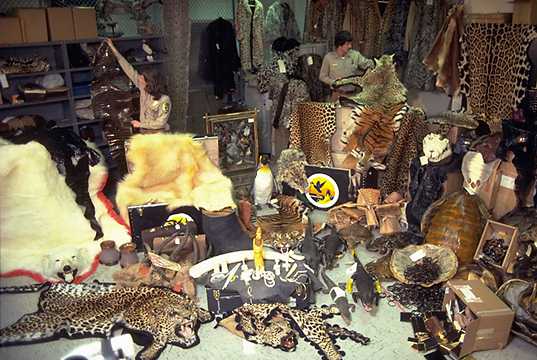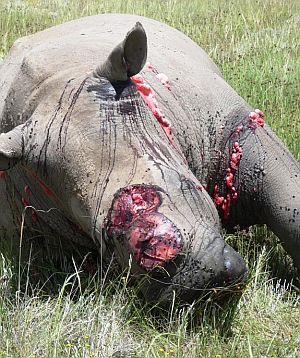How to end the illegal wildlife trade really is a question with a very simple answer – remove the demand.
It always boils down to the root of all evil – as long as people want to buy animal parts from tigers, elephants, rhinos, etc. thousands of gorgeous innocent animals will be killed.

I love sharing with you good articles from others who care about the environment. Have a look at a this interview with Steve Trent, WildAid‘s founder on The Ecologist.
***
WildAid’s Steve Trent on why only robust anti-poaching operations, undercover investigations and high profile prosecutions can save the remaining wild rhinos, elephants, tigers and sharks.
What do we need to do to stop illegal wildlife trade and specifically, rhino poaching?
The simple answer is to kill the demand. There is a real reason to say that. I’ve spent 25 years as a conservationist, and I’ve seen this from every angle.
The reality is that with a product as valuable as rhino horn, you will have illegal wildlife trade. It’s just like narcotics.
We need to have some kind of a profound sea change in attitudes and behavior in China, Vietnam and other parts of Southeast Asia, which are the major destinations of much of this trade.
If demand begins to build it will be hard to see how we can stop this. In fact, people are very good at coming up with one-stop solutions, but there is no one solution.
What you need to have are effective intelligence operations, and demand reduction. You need to back this, particularly with enforcement in countries where rhino are still lucky enough to exist. But in China, they have an obligation to crack down on the illegal trade.
Is it OK for rangers to use lethal force?
I don’t think force is ever OK. But what do you want them to do? Go out unarmed and get shot? You have to allow them to be armed. If you’ve ever been in a situation where someone is pointing a gun at you, you will know what I mean.
You have to allow them to be armed. Rangers need to do their job. If they face with a poacher trying to shoot a rhino, the poacher will point a gun at them as well.
People trying to kill animals can kill you in the process. It’s the real world that we live in.
In terms of reducing illegal wildlife trade, the key message to people should be that your purchasing decisions are fueling a gunfight where innocent people die. I’ve seen it happen.
Certainly, though, there are no simple answers, whereas rangers surely need protection, poachers are victims too. If someone offers them a lot of money to poach an elephant and sell the ivory, it’s hard to turn down.

Is dehorning rhinos a solution to stop poaching?
No, it’s not working, it’s useful in some circumstances, but you can see countless examples of where a de-horned rhino is still under threat and the nub has been cut out. Also, as a poacher, you are not necessarily looking at whether it has horns or not, so it doesn’t necessarily prevent poaching.
A kilo of rhino horn goes for $50,000 – 60,000 and this is changing all the time as demand is increasing. The level of disposable income of people is pushing price up as well. Even if it is just a small nub, it will be worth it to a poacher.
What about non-lethal rhino farms?
You’d have to be clinically insane to be promoting that. Virtually any endangered animal will have a trade in its parts, and a legal trade will operate as a cover for an illegal trade. More than that, having these kinds of farms stimulates demand.
People get confused, but this is essentially promoting a market that belongs to a highly endangered animal – and a cover for illegal wildlife trade that increases pressure on that animal.
So-called tiger farms are a nonsense. It doesn’t work. If you set up sustainable use that allows trade, there will be an illegal component.
I just returned from China where, if you talk to any conservationist, they will tell you about the illegal trade in ivory. Despite the face that there is a legal license system, these licenses are being sold on, forged, and ivory is being seized at airports.
We have clear choices, what we need is very clear political leadership; we don’t want to deal incessantly with legal machinations.

Can focussing on demand reduction really be successful?
I’d be foolish to say that WildAid focussing on demand reduction has been successful, but it is a core foundation of support. In terms of wildlife conservation, you need a portfolio of initiatives.
You need a well funded anti-poaching unit, undercover investigations and crackdowns, and demand reduction at a much greater scale.
Also, to make it socially unacceptable to have rhino horn.
Then, high profile prosecutions and serious punishment.
Finally, you need the balance of risk going against this trade.
Some of the people involved are the same people shipping drugs, women and children and arms. They are not necessarily nice people. There is a criminal aspect to this trade.
Most recently WildAid has focused on sharks, which inhabit virtually every sea and ocean. There is a fairly simple answer to conserving sharks: putting an end to shark fin soup. This would have a massive impact on shark conservation.
We’ve gotten a list of high-profile people in China, including celebrities, to back our illegal wildlife trade campaign. My relationship with the Chinese government is good. It has to be, we have to work with the Chinese government.
Often there is little understanding in the West of the cultural differences, and challenge the Chinese face. We want to work with them to become a global leader in conservation.
In the West, we tend to paint them as the devil, but if you could flip that, and make China global leaders in conservation the impact would be enormous.
What particular difficulties does Africa face in wildlife conservation?
In Africa, there are countless difficulties to wildlife conservation: human- animal conflicts, under resourced anti poaching units, and development challenges.
We need firm, clear political leadership across boundaries, this means intergovernmental coordination and cooperation.
What I want the public to understand is the impact that something purchased in China can have half way across the world. It can lead to people dying in African countries. Also, there are only some 110 elephants left in China – so these elephants are a natural heritage that belongs not to them, but to those African countries.
The market in China stimulates and drives the battles people fight in Kenya. With public awareness and political leadership we can have a relatively huge impact on this trade.
What is more, my great respect goes to the rangers who work on this, day in and out. They are the real heroes on the front lines. They are trying to protect these magnificent animals, for very little return.
What can the European Union do?
Two things – constructive, and carefully diplomatic leverage of their political power in the market and range states – not lectures – but encouragement and support with action. The second thing is financial backing.
Finally, we have to realize, that despite the euro zone crisis, we have huge amounts of wealth – with carefully calibrated aid we can make a big difference.
Further information: WildAid website
Utilizing state-of-the-art equipment, Oscar-winner Louie Psihoyos (The Cove) assembles a team of artists and activists intent on showing the world never-before-seen images that expose issues of endangered species and mass extinction.
***
Do you agree? What are your thoughts on the above?
Check out our articles on Genetically Modified Salmon, Amazing Conservation Photography, Rhino Poaching: Who is Killing Africa’s Rhinos









Africa: On World Rhino Day, South Africans will gather in lrsidaoity outside Parliament for an awareness-raising campaign on behalf of the country’s embattled rhinos. The Cape Town event is organized by Rhino Africa,
A fantastic article about an absolutely despicable practice! I agree totally, as long as a demand for this esists there will be those who practice it. The solution therefor is to eliminate the demand.